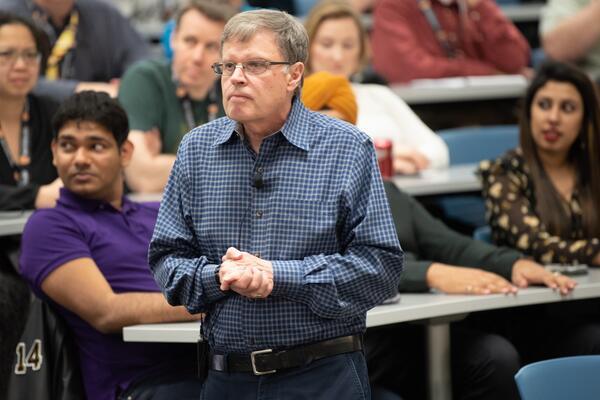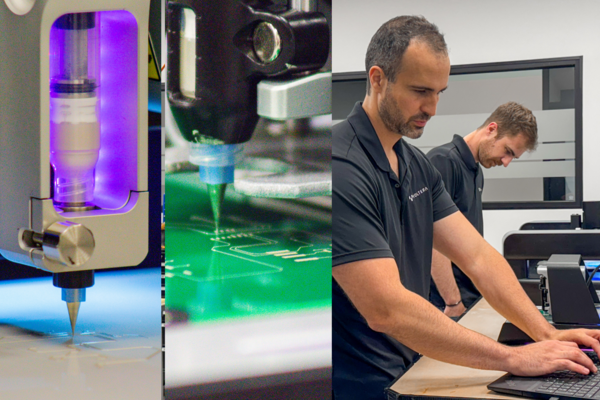It was an idea a Capstone Design team felt not only had merit but could potentially give barbershop owners a run for their money: a haircutting robot.
Two years ago, four mechatronics engineering students started working on a design for a robot that would primarily give men’s haircuts. You’d put a toonie in a slot and walk away with a number two buzz cut or another style.
“A haircutting robot — it sounds insane, I know. But it was an idea I had nursed for a while,” says team member Kathryn Lynch. “There are others out there, but it is something the technology industry really hasn’t revolutionized.”
Lynch and her fellow Capstone team members Eric Lin, Dongjae Lee, Ron Tsang (all BASC ’17, Mechatronics) passed a couple of project checkpoints, including an initial design report, before realizing there was a critical part of their project they had neglected to consider — the approximately $10K robotic arm needed to actually give the haircuts.
“As we got deeper and deeper into the project, we realized that no one would fund an expensive robot arm for us and we certainly couldn’t ourselves,” recalls Lynch. “So that was when the first flag started flying that maybe this was going to be really, really difficult.”
In December 2016, the team members met with their project supervisor, Sanjeev Bedi, a Waterloo mechanical and mechatronics engineering professor. Bedi asked the group if they thought they could complete the robot. Lynch says it was at that point she and her teammates realized they likely couldn’t finish what they had started.
“Professor Bedi sort of had that look that he’d known all along, but he let us work it out,” she says. “We kind of felt a little silly, but at the same time what we were able to come up with was in the end impressive.”
That impressive project was Grandmaster: a connected chessboard designed for users to play against online opponents on a realistic-looking board.
The team stands out to Bedi because the members took a risk with a project that didn’t pan out and then pivoted to one that did.
“I knew right off the bat that was the wrong project for them, but I follow a certain process so I let them push along the path,” he says. “They met all the deadlines, did all the steps of the design process and lo and behold at the end of the first term they came to the conclusion that this was not the right one for them.”
Bedi notes that the team, which came up with an entirely different goal and project, was able to accomplish in less than four months what others did in eight. While there’s always at least one project that fails, Bedi says Lynch’s team ended up “smelling like roses” and came away from the mechatronics engineering Capstone Design dinner with the award for best website design.
Currently looking for a job as an engineer, Lynch has included her Capstone project on her résumé as an example of how she leveraged her findings from a project that didn’t work out.
“I still strongly defend the premise of it. It just wasn’t the right time, with the right amount of resources and maybe even the right team for the project,” she says, adding with a smile, “But I still think someone out there should do it.”
From a “really big blow” to a winning project
This past spring, a chemical engineering Capstone Design project captured attention and awards both inside and outside of the University, including first place in the Ontario Engineering Competition and second place in the Canadian Engineering Competition held at Ryerson University. The wins came as somewhat of a surprise to GreenSorbs team members, whose first prototype of a boom designed to absorb and contain oil in the event of spills to prevent pollution actually did just the opposite — it released waste.
Jack Anderson, Skylar Bone, Olsi Goxhaj and Kien Tran (all BASc ’18, Chemical), had come up with the idea for a product made from the polymer fibre in old tires, otherwise destined for the landfill, to provide a better and less expensive solution for oil spill protection.
“We went into the project thinking it would be amazing if we had a reusable sorbent boom,” says Bone.
To make sure their product was marketable, the team sought input from the Eastern Canada Response Corporation (ECRC), the largest user of sorbent booms in Canada. Based on ECRC’s feedback, GreenSorbs members narrowed down the scope of their project when it was pointed out that it would be expensive and require significant energy to make the boom reusable.
After spending 40 to 50 hours a week working on the first prototype of their project, the team received bad news from ECRC: the material within the boom was being released into the environment and into the water.
“You can imagine that these booms are supposed to take oil out of the environment and that the last thing we wanted to do was have a bunch of recycled tire fibre leak into the pond,” says Bone. “That was a really big blow.”
Members took consolation in knowing that because they had used a new material for the boom, no one could have predicted how it would react in water. But it was difficult for the members, who were also roommates, to come up with a fresh solution.
“At times, when things weren’t going well, it was really frustrating because we all lived in the same house, spent endless hours in the lab together and the rest of the time sitting at home together. There was definitely time for tension to build,” Bone says.
The team eventually did move on from their failed first prototype, thanks in part to faculty member support, including that of Leonardo Simon, a chemical engineering professor and the team’s Capstone Design supervisor, who suggested they contact ECRC for feedback.
Bone and the other members eventually found another material that allowed for the oil to be absorbed but prevented the tire fibre from being ejected. It turned out to be the right combination that not only impressed judges at the provincial and national engineering competitions, but won the team funding from both the University’s Velocity program and the Faculty’s Norman Esch Entrepreneurship Awards for Capstone Design competition.
While the GreenSorbs project is currently on hold, Bone hopes the team returns to it once an Environment Canada testing facility, currently being built in Ottawa, is completed.
Experimental, risk-taking environment
Project testing and much more takes place in the Engineering Ideas Clinic®, a two-storey focal point of the new Engineering 7 building designed for professors from different engineering disciplines to collectively teach theoretical concepts to students through experimental, hands-on learning.
Bedi, director of the Engineering Ideas Clinic®, says the space provides a safe environment for risk taking, which is essential for all students but particularly those in first year. He points out that most first-year students graduate from high school with marks in the mid-to-high 90s and are accustomed to succeeding at almost everything. What they’re not accustomed to is failure.
Learning from a project that doesn’t work out is important for career growth since engineers are hired to deal with a wide variety of problems that no usual curriculum prepares them to successfully solve, Bedi explains.
“At the end of the program, we want students to reflect on what they did and what they would do differently next time around,” he says.
Sinking, literally, before moving forward
The Faculty’s Sedra Student Design Centre also provides a safe environment to experiment and take risks. Waterloo’s three-year-old Submarine Racing Team can attest to that.
It was in Maryland last year that members experienced the true meaning of the team’s tagline: Everything is simple, until you go underwater.
After passing the design report and safety inspection stages of the International Submarine Race, Waterloo’s team, known as WatSub, took to the water to compete in the race portion of the competition. That’s when, in the words of team lead Sasha Hall, everything “kind of completely flopped.”
WatSub’s entry, known as Bolt, was given several opportunities to compete in the race but had difficulty just making it past the starting line in the U.S. Naval Surface Warfare Center’s testing facility in Bethesda.
“The most promising attempt was when we had our pilot moving ahead, but then the air he was exhaling got trapped within the submarine,” says Hall, a fourth-year mechatronics engineering student. “The nose then started pointing upwards, which shot the diver towards the surface instead of straight ahead.”
During its final opportunity, the pedal-powered WatSub did make it past the starting line — albeit barely — but then sank to the bottom of the testing facility and stayed there.
It was the second year of discouraging race results for the WatSub team. In 2016, a combination of technical and logistical errors contributed to a dead-last finish at the race held in Gosport, England.
Despite the team’s poor performance two years in a row, WatSub members returned to Waterloo last year eager to start working on a brand-new design for their next
submarine. The students not only learned from the difficulties they encountered but also what worked for other teams in the competition.
Related stories

Read more
Our top 12 trending stories of 2025
Here are the people and events behind some of this year’s most compelling Waterloo stories

Read more
Empowering generations of students to reach their full potential
For more than four decades, Waterloo professor Larry Smith has helped build the University's reputation for innovation and entrepreneurial excellence

Read more
Made by Waterloo: Prototyping the future of innovation
Voltera prints electronics making prototyping faster and more affordable — accelerating research to market-ready solutions





